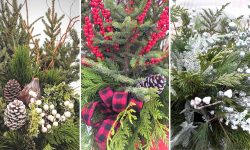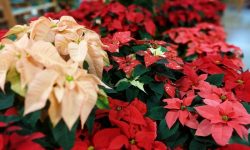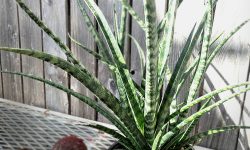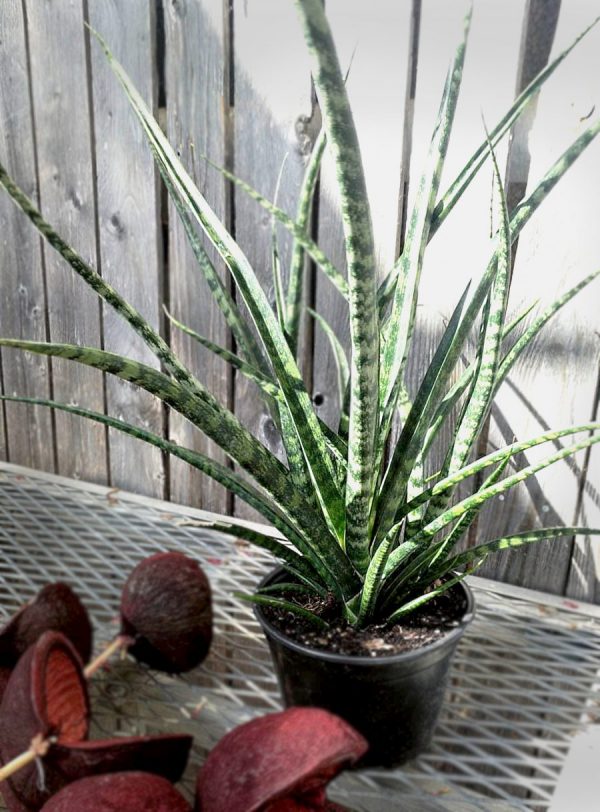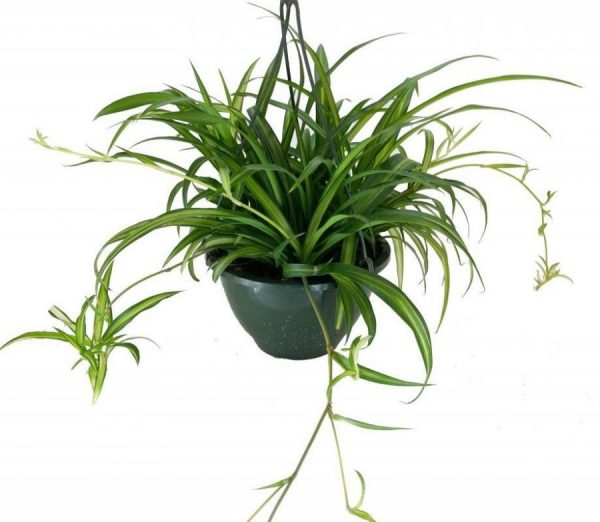
Choosing a Christmas Tree
We start the season of festive greenery early at Drummers Garden Center and Floral. Christmas Trees, as well as spruce tops, wreaths, garlands, and evergreen bundles including cedar, pine, and juniper are in around mid-November. We know some of you wave your magic wand of decorations as soon as you can and others fully enjoy just the cozy feel of the season so we have them for you before Thanksgiving!

Our Christmas Trees come from sustainably grown tree farms that focus on quality and providing freshly harvested trees. Nelson Family Farms up in Wild Rose, WI is one of our Christmas tree vendors and each year we unload a large semi full, and then hang from rafters of our greenhouse for easy viewing. The tree branches relax and you see them in their full form. We also cut the trunk, net them, and help you load if needed! The greenhouse also smells amazing with all the scent trapped inside.
We believe the trees we provide are the best value. We carry Fraser Fir, Balsam Fir, White Pine, and Victorian Fraser Fir. *See image with our four tree varieties

Tree attributes:
To help you decide on a Christmas tree this year here are a few attributes of each tree variety. The trees can vary in size 5′-14′ tall also so make sure you measure the height of the room it will be in.
White Pine: Size ranges from 6′-8′ tall and have soft, flexible needles that are bluish-green in color. Needles are 2½ – 5 in. long. They have good needle retention. These trees have little fragrance. Great for people who may have allergies to evergreen scent. These trees look so lovely with lights woven in and out of their long needles and lighter weight ornaments.
Fraser Fir: Size ranges from 6′-12′ tall and have good form and the best needle retention of all the varieties. The branches are slightly upturned. Has a pleasant fragrance. Our most popular tree!
Victorian Fraser Fir: Size ranges from 6′-14′ tall and are the same as Fraser Firs but untrimmed and space between branches are wide. This is a more traditional style of Christmas tree. True to natural form in the wild. Sometimes they are still adorned with little cones on them. Good needle retention.
Balsam Fir: Size ranges from 5′-12′ tall. These Christmas trees have the strongest and longest lasting fragrance of the tree varieties. These are relatively dense trees and have two toned needles with dark green on top and silvery green on the bottom.


Spruce Top Style Ideas
Styling a spruce top container can be a lot of fun but sometimes daunting if there are so many options! That’s why we put together three styles for you! Add or take away what you want or grab the whole decoration bundle while in the store when you are getting your evergreens!
Without any further delay, here are the three easy styles!
Woodsy Winter Neutrals

Ingredients:
Curly Willow
Frosted Cones
White berries
Sakai Pod
Greens: Spruce, Pine, Cedar, and Berried Juniper
Recommended add-ins: Magnolia or Eucalyptus Leaves, Variegated Oregonia bundle, Dried Hydrangea Flowers
Classic Christmas

Ingredients:
Red Twig Dogwood
Birch Pole
Red Berries
White-tipped Pine Cones
Buffalo Check Ribbon
Greens: Spruce tops, Cedar, Pine
Recommended add-ons: Broom Bloom ( Neutral or Red), Red Ornaments
Glitzy Frost

Ingredients:
Metallic Green Berries
Frosted and Silvery Evergreen Foliage
Greens: Norway Pine, White Pine, Shore Pine, Cedar
Recommended add-ins: Short spruce tops if you want height, metallic globes, glitter pine cones, or glitter vines.

Poinsettias
Originally red, poinsettias are available in a huge variety of sizes and colors.
The best tips for keeping poinsettias in good shape are: keep them out of drafts, allow them to dry slightly between watering, and be sure to empty excess water from the bottom tray or cover provided when you purchased it. Here is Minnesota Gardener’s guide to caring for Poinsettias during the Holiday and year-round!
In season, purchase these beautiful plants in our store or on our floral website.

It’s the bracts of the plant, or modified leaves, that provide most of the color to poinsettias. The flower itself does provide a bright spot of color, see it? The yellow flowers are located in the center of each colorful bract.

Easy Care Houseplants
Connecting with nature is important especially since it’s easy to be disconnected from it these days. Houseplants in the home or office have proven to improve mental health and keep that connection with nature.
We get that not everyone can be a perfect plant parent and take care of ALL varieties of houseplants. This gallery of houseplants are ones that can handle a more “hands off” approach. Although these are easy plants to take care of, they still do have specific light, water, and nutritional needs. Most of these have similar needs but please research and ask about their individual care. We are happy to help!
*Note: All of these houseplants have different variations so the images are just a representation. For example, Aglaonema can have pale pinks or orange in the leaf or the Sansevieria varieties can have different leaf shapes!
 Pothos
Pothos
 Sansevieria
Sansevieria
 ZZ Plant
ZZ Plant
 Spider Plant
Spider Plant
 Aloe Vera
Aloe Vera
 Aglaonema
Aglaonema
 Succulents and Cactus
Succulents and Cactus

Winter Houseplant Basics
It can be a tough time for our plant babies due to the cold, dryness indoors, and lack of sunlight but it doesn’t take much to keep your plants healthy if you know what they are needing at this time. Winter houseplant basic care in the winter is simple and the rules below should help you take care of your houseplants! Remember houseplants are usually a form of tropical plant and we want to mimic that environment, within reason of course.
Houseplants keep our connection with nature, provide health benefits, and add beautiful color to our rooms. Let’s go over a few things to prevent complete loss and provide optimal houseplant care in the winter.
1.Big no-no! Taking the plant outside with no protection.
Houseplants are available all year-roundso we may not think about what the cold weather can do to the plants if they are exposed to the extreme temperature differences. When it is below 50 degrees, as the winters are in MN, plants do not like to be exposed to the cold. Think of plants like us. We can’t go outside without a protective layer in freezing temps. When buying a houseplant, make sure it gets wrapped up in plastic or paper before you leave the store and do not keep in the car without heat for long.
2.Add humidity around with trays with pebbles and water when humidity is low.
With the heaters going in the house, this can drop humidity levels drastically. If you don’t want to buy a humidifier for the rooms that you or your plant are in (humidity is good for us too!) , this is a good method to increase humidity around our houseplants. Fill a tray underneath your plant with pebbles. Make sure your plant is never sitting in the water so it still needs a smaller saucer underneath the actual pot. When the water evaporates, the humidity is elevated around the plant. Keep the tray filled with water. This also helps prevent spider mites since they love dry plants! 50-60 percent relative humidity is a good level for both people and plants. Some thin leafed plants may need up to 70 percent. Even succulents/cactus don’t mind humidity at 40 percent or more!
3. Make sure the warm air isn’t blowing directly onto the plants.
Along with humidity you must pay attention to temperature. Quick fluctuations of cold and heat can damage the foliage of a plant and dry it out too quickly. Buy a duct cover to direct airflow or move the plant away from the heating vent.
4. Make sure the leaves aren’t touching the windows.
The leaves touching the window are probably going to be damaged by the cold. You can put a barrier between them and the window if possible. Cardboard or some other form of protection if you don’t mind the obstructed view if you absolutely need the plants that close to a window.
5. Do not re-pot your plant into a larger pot in the winter.
Your houseplant is probably not actively growing and will do better up-potted in the spring or before November. If you do need to pot up, just pot 1-1/2 inches up and make sure you are paying very close attention to the water level in the soil! We don’t want to drown them. Pay attention to plants potting needs also. For example, Jade plant likes to be snug in its pot.
6. Hold off fertilizing your houseplants until March.
If a plant is over-fertilized in the winter it can create weak growth. Think of your plant as on a diet and ramp up the feedings around spring time.
7. Reduce watering frequency.
Too much watering is a common mistake people make with their houseplants. It really all depends on the environment in your home but before you water always check to see if the soil is dry before watering. If it’s damp, hold off. Succulents, cactus, sanseveria, zz plants, rubber plants, and pothos, are examples of houseplants that you can let the soil go completely dry before watering. Some plants, like prayer plants, ferns, and spider plants can be watered when the first inch of soil is dry yet still a bit damp deeper in the soil. Research your individual plant needs to find out their preferred watering schedule! You will get the hang of it quickly for each plant.
Don’t give up all hope if some houseplants don’t survive. Houseplant care shouldn’t be stressful! You just may need to try a different plant for your home! To keep our houseplants happy we do have to pay attention to what certain varieties of plants prefer so if you have any questions please feel free to call or email us with questions! Pictures help us diagnose issues also.





